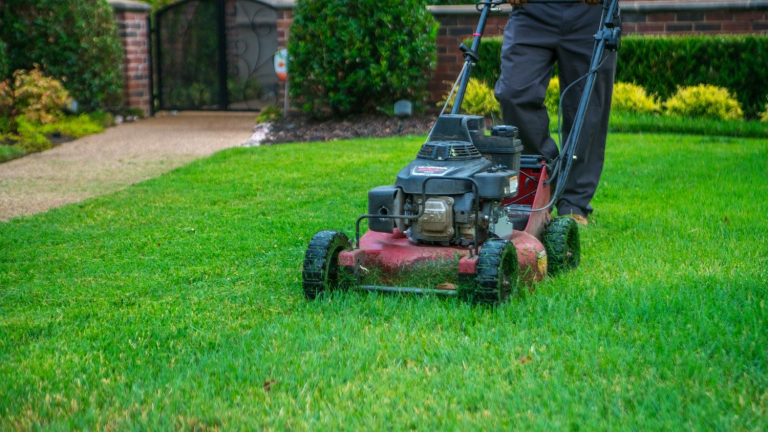The numbers are shocking – 35,000 injuries and almost 100 deaths happen every year from riding lawnmower accidents in the United States.
The reported statistics demonstrate why homeowners must treat lawn mower safety as an essential matter. What makes these machines so dangerous? The speed at which a mower can launch debris reaches 200 miles per hour. The loss of equipment control leads to accidents because operators either slip off their equipment or become trapped beneath it.
Lawn mower accidents can affect anyone. The way you mow your lawn on slopes determines your safety because slope conditions remain one of the most dangerous aspects of mowing.
Texas homeowners need to be aware of all the safety considerations for lawn mowers to keep their families protected. Understanding how to handle slopes, perform equipment checks, and use protective gear is crucial, but accidents can still occur despite taking precautions. In such cases, Texas state accident info can help homeowners navigate the next steps if an incident results in injury.
Know Your Equipment and Safety Features
Modern lawn mowers include multiple safety features which help prevent injuries to people and their body parts. The knowledge of these features enables operators to work safely.
Operator Presence Control (OPC)
The operator presence control (OPC) functions as the core safety innovation. The system stops the blades from spinning within three seconds when you step away from the seat or let go of the controls. The design prevents accidental contact with the rotating blades.
Rollover Protection System (ROPS)
The Rollover Protection System (ROPS) gives riding mowers vital protection against tip-overs. The steel frame structure of the machine includes folding features for storage needs and seat belts serve as protective measures to prevent operators from getting caught by the equipment. The ROPS system functions as a protective system only when the seat belt stays fastened.
Safety Switches
Safety switches function as silent protectors that safeguard people from electrical hazards.
- Seat switches shut off the engine when no weight is detected
- Interlocks prevent starting the engine while in gear
- Reverse operation systems stop the engine if you try to reverse with blades engaged
These safety devices should never be removed or bypassed. Equipment warning labels require regular inspection because they display potential risks through signal words such as “DANGER,” “WARNING,” and “CAUTION.”
The small safety features on mowers help stop about 70,000 annual emergency room visits for mower-related injuries.
Prepare for Safe Operation
The right preparation can save you from a trip to the emergency room when you start your mower.
You need to get a full picture before mowing. Start by checking the oil and fuel levels and tire pressure and examining the blades for any signs of damage or wear. All belts need to be in good condition while control levers should function correctly and safety switches must be active.
Your mower blades can turn yard debris into dangerous projectiles that fly over 50 feet. Take a walk around your property and pick up any sticks, stones, toys, and other objects before you start. Keep children and pets away from the area where you’ll be mowing.
Personal Protective Equipment (PPE)
- Sturdy, closed-toe footwear (never sandals or flip-flops)
- Long pants to shield against flying debris
- Eye protection (safety glasses or goggles)
- Hearing protection (ear plugs or muffs) since mowers can be around 100 decibels
- Gloves that fit properly to maintain better hand grip and protect hands
Stay focused while mowing – put your cell phone away, take off headphones, and of course never mow after drinking alcohol.
Take time to read the owner’s manual. You can find most manuals online by searching your mower’s model number if you don’t have the original copy.
Be careful when moving through areas with slopes and dangerous terrain.
Mowing Slopes and Hazardous Terrain

The most hazardous situation for lawn mowers occurs when operating on sloping terrain. Research shows that hill mowing leads to tractor rollover accidents, which kill more people than any other lawn mower accident.
The following safety rules will protect you from harm when you are on slopes:
- The owner’s manual establishes particular slope limits which must not reach 15 degrees
- Cut grass up and down slopes instead of across them to stay safer
- Wet grass reduces your traction on inclines
- Maintain a steady pace during your movements while you shift between different directions
- Maintain a minimum distance of five feet from drop-offs, ditches, embankments, and retaining walls
Water areas require special maintenance. Grass near ponds, creeks, and other water bodies becomes slippery. String trimmers together with push mowers prove more effective than riding equipment for these areas.
Moving your mower needs careful planning. Secure your equipment properly on trailers to avoid accidents – a mower falling off could be catastrophic. Always handle the load and unload process with equal attention as if you were performing it for the first time.
The uneven terrain creates multiple dangers for people who walk on it. Check the area for holes, ruts, and bumps that could cause your mower to flip. People can avoid common accidents by staying alert.
Conclusion
Texas homeowners must follow lawn mower safety guidelines to create beautiful lawns while avoiding accidents. The protective features of your equipment form the basis of safety because they include operator presence controls and rollover protection systems. The built-in security measures need users to activate them correctly and maintain their operation for them to function properly.
Taking time to prepare before mowing reduces accident risks by a lot. Start by clearing your yard of debris while wearing proper protective equipment and keeping children and pets at a safe distance before beginning your mowing operation. On top of that, it helps to keep your mower in top shape to prevent mechanical failures that could cause accidents.
The most dangerous aspects of lawn care occur when working on slopes and uneven ground. Note that you need to use proper mowing techniques on hills and stay watchful around water hazards. Your investment in safety precautions will stop you from joining the thousands of people who get hurt in lawn mower accidents each year.
Lawn mower accidents can happen to anyone, regardless of age or experience. The operators at all levels must remain vigilant at all times. Your commitment to follow these guidelines at all times ensures your safety and the safety of others.
A well-kept lawn makes your Texas home look beautiful, but no perfect lawn is worth risking your health or life. The combination of good equipment understanding, proper preparation, and safe operation methods enables us to use our outdoor areas while protecting our loved ones.













